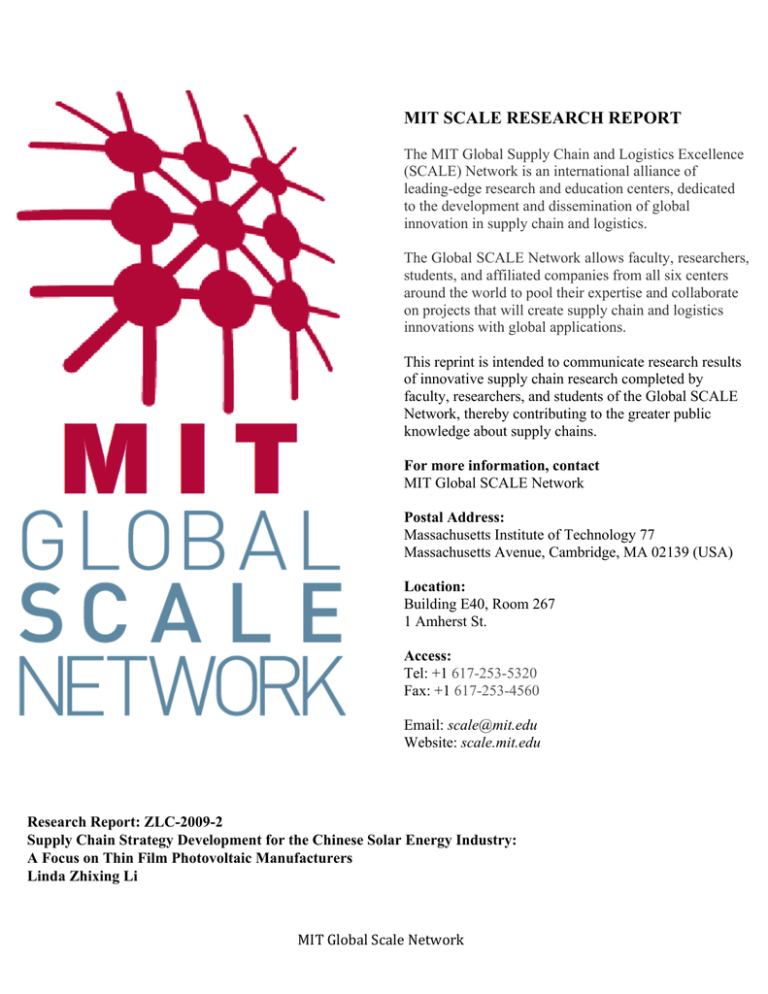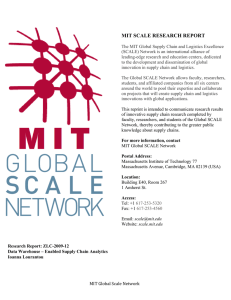MIT SCALE RESEARCH REPORT
advertisement

MIT SCALE RESEARCH REPORT The MIT Global Supply Chain and Logistics Excellence (SCALE) Network is an international alliance of leading-edge research and education centers, dedicated to the development and dissemination of global innovation in supply chain and logistics. The Global SCALE Network allows faculty, researchers, students, and affiliated companies from all six centers around the world to pool their expertise and collaborate on projects that will create supply chain and logistics innovations with global applications. This reprint is intended to communicate research results of innovative supply chain research completed by faculty, researchers, and students of the Global SCALE Network, thereby contributing to the greater public knowledge about supply chains. For more information, contact MIT Global SCALE Network Postal Address: Massachusetts Institute of Technology 77 Massachusetts Avenue, Cambridge, MA 02139 (USA) Location: Building E40, Room 267 1 Amherst St. Access: Tel: +1 617-253-5320 Fax: +1 617-253-4560 Email: scale@mit.edu Website: scale.mit.edu Research Report: ZLC-2009-2 Supply Chain Strategy Development for the Chinese Solar Energy Industry: A Focus on Thin Film Photovoltaic Manufacturers Linda Zhixing Li MITGlobalScaleNetwork For Full Thesis Version Please Contact: Marta Romero ZLOG Director Zaragoza Logistics Center (ZLC) Edificio Náyade 5, C/Bari 55 – PLAZA 50197 Zaragoza, SPAIN Email: mromero@zlc.edu.es Telephone: +34 976 077 605 MITGlobalScaleNetwork ________________________________________________________ Supply Chain Strategy Development for the Chinese Solar Energy Industry: A Focus on Thin Film Photovoltaic Manufacturers Linda Zhixing Li EXECUTIVE SUMMARY ________________________________________________________ This thesis focuses on the Chinese solar energy industry, using a particular Chinese thin film solar cell manufacturer (the Firm) that is currently undergoing a vertical integration process as an exemplary case. The purpose is to examine the unique set of challenges and opportunities confronting this industry, and apply a set of frameworks to thereby derive insights for the supply chain strategy development of the Firm. The current stage of development of the Firm raises some important questions such as: What are the potential sources of change, challenges, and opportunities as the Firm progresses along its vertical integration path? Which approaches can be used to develop its operations strategy and supply chain management polices? Most importantly, what is the right supply chain for the firm’s current products and future product lines? By investigating current studies in technological, manufacturing, and market aspects of the thin film solar cell industry, and by examining the competitive environment in which the Firm operates, potential challenges and opportunities in its value chain have been identified. By developing a series of analyses and frameworks, a supply chain strategy formation process suitable for the Firm’s current business goals is delivered and insights into possible supply chain transformations for which the Firm will need to prepare for are offered. The impact of reverse logistics (recycling of thin film solar cells after the end of their useful life) is addressed as well as the impact of government intervention and lessons-learned from developed solar industries in order to offer insights on how the economic realities of the market directs the players in the industry towards value creation through quality and efficiency improvements and overall cost reduction. Key Findings Change in the nature of demand for the Firm: As the Firm progresses down its vertical integration path, the nature of demand for its products shifts from functional to innovative. Manufacturing processes shift from made-to-stock for functional products to engineering-to-order for innovative products and complete systems applications. Lead time requirements, product life cycle, and demand uncertainties are all subject to change as the Firm vertically integrates. High demand of silane gas: One of the most important raw materials for thin film photovoltaic (TFPV) manufacturing, silane gas is chemically hazardous nature, so transportation and storage are subject to regulatory constraints. For TFPV manufacturers, Executive Summary, MIT-Zaragoza Master’s Thesis, 2009 1 Title securing silane supply and hedging against potential price changes are essential to achieve cost leadership and stability. Recycling: Due to concerns about regulated chemical materials, recycling and disposing of TFPV modules may become a partial, if not full, responsibility of module manufacturers. Building recycling and reverse logistics capabilities within a supply chain would enhance innovative competitiveness and may create barriers to rival entries. Impact of Chinese “Renewable Energy Law”: Small-scale PV applications such as rural electrification projects would grow and attract private sector investors, which would offer lucrative business opportunities to solar cell manufacturers, especially to those who are vertically integrated with both product and systems engineering capabilities. Recommendations: Manage silane gas suppliers as strategic partners: The Firm should communicate and meet with domestic gas suppliers to develop long-term contracts to prevent disturbances from price hikes, as well as inventory and transportation uncertainties. Develop a supply chain strategy as appropriate to vertical integration: The Firm should devise supply chain strategies according to the nature of the demand for its products, that is, use physically efficient supply chains to minimize physical costs involved in material management, production planning, and delivery of its functional products. The Firm should also use responsive supply chains to increase the flexibility and speed of responding to changes in technology, market, and system-engineering requirements. Prepare for supply chain transformation: The Firm should (1) develop strategic partnerships with third-party logistics service providers to leverage their expertise and economies of scale in order to reduce physical costs and transaction costs; (2) define, build, and enhance supplier competence, relationships, processes, and toolsets to maximize the long-term and sustainable value of the commercial agreements between the Firm and its key suppliers and customers; (3) invest in a responsive supply chain for the future and consider having both physically efficient and responsive supply chains in parallel to support different product groups and avoid paradoxical supply chain management policies. Build reverse logistics capabilities into the supply chain: The Firm should build RL considerations into its products at the product development stage such that products are designed and made for easy disassembly, reuse, and remanufacturing. It should consider building its own small-scale recycling capacity, in which the use of hydrometallurgical separations could be economical. It is also important to build awareness and contractual relationships with customers at an early stage to enable retrieval of their obsolete/scrapped products to collection points established by the manufacturer. Create economies of customization for BIPV systems: The Firm should invest and build supplier relationships for key subsystems (e.g., BOS) assemblies, systems engineering development (in addition to product development), training, and after-sell services to improve transactional and customization efficiencies. Invest in supply chain information systems: The Firm should strive to use information to create transparent and visible demand patterns and to create an efficient balance of supply and demand by an integrated and coordinated manufacturing planning and control system. Future Research & Investigation: Further research studies are suggested for focusing on scenario analysis and the influence of market economics and policy issues on the PV industry value chain and supply chain networks. Executive Summary, MIT-Zaragoza Master’s Thesis, 2009 2


